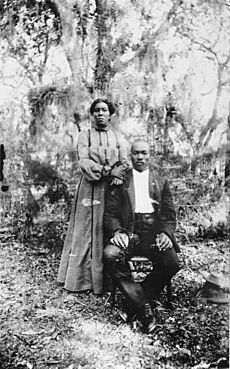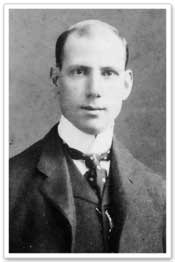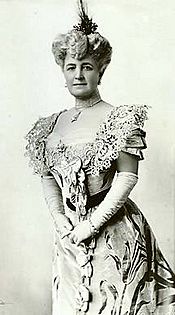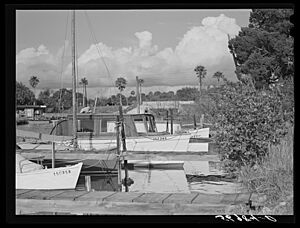History of Sarasota, Florida facts for kids
Sarasota, Florida, first appeared on old maps. A Spanish map from 1763 called the area "Zarazote." Later, a British map from 1776 showed "Boca Sarasota."
Sarasota became an official town in 1902. It grew and became a city a few years later. In 1921, Sarasota County was created from Manatee County. Sarasota city became the main city, or "county seat," for the new county.
Contents
- Discovering Sarasota's Beginnings
- Important People in Sarasota's History
- Sarasota in the Late 1800s
- Sarasota in the 1900s and 2000s
Discovering Sarasota's Beginnings
How Old Is Sarasota?
About 15,000 years ago, the first people came to Florida. At that time, the Gulf of Mexico shoreline was much farther west. People survived by hunting animals and gathering plants. They lived near water sources like deep springs. Places like Warm Mineral Springs were good campsites.
As huge glaciers slowly melted, the climate became warmer. Sea levels rose about 350 feet (107 meters). This created Florida's shoreline as we know it today. These new shorelines were great places for people to live.
Archaeologists have found signs that people lived in Sarasota for over 10,000 years. For 5,000 years, fishing in Sarasota Bay was a main food source. Huge piles of shells and fish bones show where these early settlements were.
Who Were Sarasota's First People?
The people living in the Sarasota area were part of the Manasota culture. This group lived here from about 500 B.C. to 900 A.D. Later, the Safety Harbor culture grew from the Manasota culture around 900 A.D.
Safety Harbor people built large mounds, often for temples. About twenty temple mound sites are known. One was the Whitaker Mound in downtown Sarasota. "Mound Street" was named after it. Sadly, many mounds were removed in the 1900s for new buildings.
Spanish Explorers Arrive
Europeans first explored this area in the early 1500s. The first recorded visit was in 1513. A Spanish group landed south of Sarasota, at Charlotte Harbor. Natives already knew some Spanish words. This suggests earlier meetings with Europeans.
In 1539, a Spanish explorer named Hernando de Soto sailed into Tampa Bay. He landed near the Manatee River. On old maps, the smaller bay nearby was called Zara Zota or Sarasota.
Early European Settlements
Sarasota Bay was known for its many fish. During the second Spanish Colonial period (1783-1821), Spanish fishermen from Cuba set up "ranchos," or fishing camps. They traded fish and turtles with merchants in Havana.
After the War of 1812, some British soldiers settled near Tampa Bay. They started a farming community on Sarasota Bay. Later, many formerly enslaved people and Creek Indians moved into the area.
In 1823, the Treaty of Moultrie Creek moved most Native Americans to a reservation. This reservation was in the middle of Florida.
Fort Armistead: A Short-Lived Fort
In May 1840, General Walker Keith Armistead built Fort Armistead in Sarasota. This was during the Second Seminole War. The fort was likely in the Indian Beach area. It only lasted seven months.
The army built the fort at a fishing camp run by Louis Pacheco. He was an African slave working for his Cuban-American owner. The fort was abandoned due to sickness. Before it closed, Seminole and Miccosukee leaders met there. They discussed moving to Indian Territory.
After the Second Seminole War ended in 1842, many Americans moved to Florida. They used the Armed Occupation Act to get land. Florida became the 27th state in 1845. More new residents led to the Third Seminole War almost ten years later.
Sarasota During the Civil War
In 1860, Sarasota was part of Manatee County. Some historians believe people in Manatee County were not eager to leave the United States. Only 20 slave owners lived there in 1860. Still, the county started a local army group that year. Over a hundred men from the county joined the Confederate army.
Union soldiers sometimes raided the Sarasota area. They wanted to weaken support for the Confederacy. They also aimed to take supplies. A.K. Whitaker, a local settler, moved his cattle away from Sarasota Bay. This was to protect them from Union raiders. Union raiders also destroyed many salt-making operations.
During the time when the Union army occupied Florida, A.K. Whitaker's wife, Mary, met a Union soldier. She reportedly gave him matches and challenged him. Their house was not burned, but others in the Manatee region were.
Important People in Sarasota's History
Many people and families helped Sarasota grow. Here are some of them.
The Whitaker Family William Whitaker was the first European pioneer to live permanently in Sarasota. He built his home north of present-day Eleventh Street. He sold dried fish to Cuban traders. In 1847, he started a cattle business.
A. B. Edwards Arthur Britton Edwards, known as A. B. Edwards, was born in 1874. His parents settled in the area after the Civil War. His parents died when he was fourteen. He then supported his brothers and sisters. Edwards helped bring many people and developers to Sarasota. When Sarasota became a city, he was elected its first mayor in 1914.
The Webb Family In 1867, John G. Webb and his family moved to Florida from New York. They met a Spanish trader in Key West. He told them about a good place for a home on Sarasota Bay. The Webbs found the spot with William Whitaker's help. It was south of the Whitakers' home. The Webbs named their home Spanish Point after the trader.
Lewis Colson Lewis Colson was born in 1844. He came to Sarasota in 1894 as a surveyor. Colson was a former slave, a fisherman, and a reverend. He and his wife, Irene, settled in the Black Bottom neighborhood. This area was later called Overtown. Colson helped survey the town. He later gave land to build the first African American church, Bethlehem Baptist Church. He was its reverend from 1899 to 1915.
Historians describe Colson as a very respected Black man in Sarasota. Overtown became a busy community with businesses and churches. The Colson Hotel, built in 1926, was named after him. It served African American tourists until the 1950s. Colson Avenue is also named in his honor. A historical marker in downtown Sarasota credits him with marking the center of Five Points. Lewis Colson and his wife Irene are the only African Americans buried in Rosemary Cemetery.
Browning and Gillespie In 1885, a group of Scottish people started a colony in Sarasota. It was advertised as a tropical paradise. But when the "Ormiston Colony" investors arrived, they found few homes or stores.
Only a few Scots, like the Browning family, stayed. John Hamilton Gillespie, a manager for the Florida Mortgage & Investment Company, also stayed. He began to develop Sarasota. In 1887, he built the De Soto Hotel. It opened with a big celebration. Tourists started arriving by ship. Gillespie also built a golf course. By 1905, it was a large nine-hole course.
Owen Burns Owen Burns came to Sarasota for fishing and stayed. He became the largest landowner in the city. He started a bank and helped other businesses. He built bridges, famous buildings, and mansions. He dug out the harbor and created new land along the bay. He also built unique areas like Burns Court to attract tourists.
Burns partnered with John Ringling to develop barrier islands. This decision led to his financial ruin when Ringling did not keep his promises. In 1925, Burns built the El Vernona Hotel, named after his wife. The Florida land boom crash soon after hurt his finances badly. John Ringling then bought the hotel from Burns for much less than it was worth. Ironically, Ringling also lost most of his money later.
Besides his buildings, Burns helped bring many people to Sarasota. His daughter, Lillian G. Burns, became an important historian for the community.
Bertha Palmer Bertha Palmer was the biggest landowner and developer in the area around 1900. She bought over 90,000 acres (364 square kilometers) of land. She was drawn to Sarasota by an advertisement from A. B. Edwards. They worked together for many years. The Palmer National Bank, started by her sons, stayed strong through the Great Depression.
Bertha Palmer also owned land that is now Myakka State Park. She ran a ranch there. She developed new ways to raise cattle in Florida. At her "Meadowsweet Farms," she also started large-scale farming and dairy. She helped develop crops that could be shipped to other parts of the country. The "Celery Fields" today are on land she developed for growing celery.
As war in Europe approached, Bertha Palmer promoted Sarasota's beauty. She wanted wealthy people to visit Sarasota instead of Europe. Palmer built a resort on the Webb family's old homestead. She quickly made Sarasota a popular winter spot for the rich. This helped Sarasota become a famous vacation place.
Palmer said Sarasota Bay was as beautiful as the Bay of Naples. She also promoted its sport fishing. Over time, too much fishing reduced the marine life in the bay.
Palmer kept most of the original Webb Family buildings. She greatly expanded the settlement. This historic site, Historic Spanish Point, is now open to the public.
Owen Burns followed Bertha Palmer to Sarasota in 1910. He soon became the largest landowner within the city limits. Many roads in Sarasota County are named after trails she created. Her sons continued her businesses after her death in 1918. Bertha Palmer helped make Sarasota famous. Two state parks, Oscar Scherer State Park and Myakka River State Park, are on land she once owned.
Sarasota in the Late 1800s
In 1890, the U.S. Army Corps of Engineers began digging waterways. This created the Gulf Intracoastal Waterway (ICW). The ICW connects the Sarasota Bay system. It uses natural deep water areas and human-made channels. The goal was to connect Southwest Florida to the national waterway network. The ICW helped Sarasota and the surrounding area grow a lot.
On June 1, 1899, the Sarasota Times newspaper published its first issue. It was later renamed Sarasota County Times.
Sarasota in the 1900s and 2000s
Early 1900s: Sarasota Becomes a City
Sarasota officially became a town on October 14, 1902. It had 53 residents. John Hamilton Gillespie became the mayor. In 1913, it was incorporated as a city. A. B. Edwards became its first mayor.
Other communities around Sarasota also grew. Some were later absorbed as Sarasota expanded. Today, some of these areas are known as neighborhoods. Overtown, Sarasota's first African-American neighborhood, was lost due to urban renewal. It was renamed the Rosemary District in 1994.
The railroad also helped Sarasota grow. In 1902, a railroad bridge was built across the Manatee River, north of Sarasota. Ten years later, in 1912, the first bridge south to Bradenton was built.
The 1910s: The Ringling Family Arrives
In 1895, Mary Louise and Charles N. Thompson developed Shell Beach. They built their home there. From 1911 on, Mable and John Ringling spent their winters in that house. They eventually bought it and a large piece of land. Charles N. Thompson was also a manager for a circus. He attracted several members of the Ringling family to Sarasota. They came for winter retreats and to invest in land.
The Alf T. Ringling family was the first to settle in the Whitfield Estates area. The families of Charles and John Ringling followed. Soon, more Ringling family members came to Sarasota. After Alf T. died in 1919, Charles Ringling took on many of his duties.
Charles Ringling invested in land and developed properties. He also started a bank. He was active in Sarasota's community life. He loaned money to new businesses. He supported creating a separate county government for Sarasota. He even donated land and built the county's government offices and courthouse as a gift.
Ringling Boulevard is named after Charles Ringling. He built the Sarasota Terrace Hotel, a tall building, near the site he donated for the county seat.
Charles Ringling and his wife, Edith, began building their winter home in the early 1920s. Charles Ringling died in 1926, just after it was finished. Edith Ringling lived there for decades. She continued to help run the circus and supported cultural activities. Their home is now the center of the New College of Florida campus.
New Developments in the 1910s
Many modern improvements came to Sarasota in the 1910s. The city's sewer and water system was expanded. The first paved road to Venice was built.
In 1913, two sisters, Katherine and Daisietta McClellan, became real estate developers. They created the McClellan Park subdivision. Its design was unique because it did not use a typical grid system. It included a yacht basin and tennis courts.
City Island is an artificial island created during this time. Starting in 1914, a deep channel was dug to create a port. The port was not very successful.
As Sarasota grew, so did its African-American population. But the Overtown neighborhood could not expand much. In 1914, the Newtown neighborhood was established further north. Newtown is now a historic place.
In 1915, local leaders formed a committee to improve roads and bridges. They planned to build 34 miles of paved roads. This would make travel easier between Sarasota and nearby communities. Construction slowed during World War I. The work that was finished was not very good. For example, the bridge to Siesta Key started falling apart quickly. This frustration helped Sarasota citizens want their own county.
The Woman's Club of Sarasota was founded in 1913 with 63 members. This group worked to improve the community. They supported local schools and libraries. The organization is still active today.
After World War I: Sarasota Grows Fast
After World War I, Sarasota experienced an economic boom. Many new people came looking for jobs and investments.
In the 1920s, Sarasota continued to progress. Electricity became reliable with a new power station in 1920. In 1921, Sarasota County was created. Sarasota became the county seat.
In 1923, Sarasota citizens built a baseball field and grandstand. This facility became Payne Park. In 1924, the city convinced the New York Giants baseball team to use Payne Park for spring training. John Ringling reportedly helped with this decision. The Giants used the park until 1927.
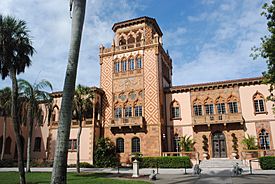
Sarasota grew a lot during the Florida Land Boom of the 1920s. The population around Sarasota jumped from 3,000 in 1920 to over 15,000 by 1926. By the late 1920s, Sarasota was the largest city on Florida's Gulf Coast south of St. Petersburg. Sarasota County became one of the wealthiest counties in the United States.
John Ringling was a very important real estate developer. He wanted to make Sarasota a resort town like those on Florida's East Coast. He planned casinos, bayside homes, yacht basins, and resorts.
The Great Depression and World War II
The good times ended early for Sarasota. Florida was the first state affected by the financial problems that led to the Great Depression. In 1926, land speculation collapsed. Banks failed on Florida's eastern coast. These financial problems spread across Florida.
John Ringling initially benefited from the economic crash. He caused his partner, Owen Burns, to go bankrupt. Ringling then bought the famous El Vernona Hotel from Burns for a very low price. However, John Ringling soon lost most of his own money. His wife, Mable, died in June 1929. Then, the stock market crash affected his investments.
Before the market crashed, Ringling bought several other circuses. He hoped to combine them and sell shares. The crash ended that plan. Ringling kept buying expensive artwork. But he left big projects unfinished, like a Ritz hotel. He also abandoned plans for an art school.
The circus board, including Edith Ringling, removed John Ringling from his leadership role. By his death in 1936, John Ringling was almost bankrupt. His estate was saved because he had left his art collection and property to the state.
Financial Challenges
During the Great Depression, Sarasota faced a financial crisis. The city was $6 million in debt. This was due to unpaid bonds, taxes, and property assessments. Many cities during the Florida Land Boom issued bonds for new buildings. This later led to debt.
Sarasota's city limits had grown from under 2 square miles (5 square kilometers) to 67 square miles (174 square kilometers) in 1925. To save money, the city limits were reduced to 17 square miles (44 square kilometers) in December 1926.
How Sarasota Recovered
Starting in 1927, the circus made Sarasota its winter home. This lasted until 1959. This helped Sarasota during the Great Depression. It brought tourists and seasonal jobs. Federal relief projects also provided jobs.
Despite the bad economy, Sarasota's population grew by almost 50 percent. People survived by growing their own food and trading goods. There was little money available. A committee found that jobs were rare and often went to non-residents. They asked employers to hire as many people as possible. Transient workers were also an issue. They would cut wood for food or coffee. Then, they were asked to leave the city with a police escort.
Tourism remained a main part of Sarasota's economy. The city began to recover in 1935. By 1936, Sarasota saw the most building permits since 1927.
With federal funding, several important projects were completed. These included the Municipal Auditorium, Bayfront Park, the Sarasota-Bradenton Airport terminal, and the Lido Casino.
In 1942, the U.S. joined World War II. The Sarasota-Bradenton airport was leased to the U.S. Army Air Corps. The 97th Bombardment Group was stationed there first. But their B-17 Bombers were too heavy. So, the airfield became a training ground for fighter planes.
Mid-Century Growth: 1950s - 1990s
1950s and 1960s
Sarasota grew rapidly in the 1950s. This was part of the economic boom after World War II. New neighborhoods were built, like Kensington Park and Southgate. Downtown Sarasota became less of the city's main center. The city's population also increased.
Tamiami Trail was rerouted to improve traffic flow. This created the Bayfront Drive area. Property owners on Gulfstream Avenue did not like the changes. But the project went ahead.
In 1951, Cecil B. DeMille filmed "The Greatest Show on Earth" in Sarasota. This brought money to local businesses and made the city more famous.
Bayfront areas changed in the 1960s. The Hoover Arcade, which housed Sarasota City Hall, was torn down in 1967. The city wanted a more modern city hall.
The Civil Rights Movement in Sarasota
Like many U.S. cities, Sarasota experienced social changes during the Civil Rights Movement. The community had racial segregation. African-American residents needed a work permit to go outside Overtown and Newtown.
The Sarasota NAACP organized a "wade-in" protest on October 2, 1955. Black residents had asked for a public beach for years. After the protest, most local residents and city leaders wanted to create a beach for African Americans. However, they could not find a suitable location. Residents in Longboat Key protested against a Black beach there. They decided to become a municipality to avoid it. Protests continued weekly until all beaches were desegregated.
The city government was against integrating the beaches. In 1956, an ordinance was passed. It allowed police to remove people from a public beach if two racial groups were present. After failing to designate a Black beach, the city proposed building a pool in Newtown. The pool opened in 1957. Protests paused during construction but resumed because African American residents wanted beach access.
In 1957, the NAACP asked the Sarasota County school board to desegregate schools. They did not. In 1961, the NAACP sued the school board. That same year, the federal government threatened to stop funding beach erosion projects if Sarasota continued to segregate its beaches.
In 1962, the county school board integrated its first school, Bay Haven Elementary. Black students were allowed to enroll. It is unclear exactly when beaches were desegregated. It is thought to have happened when the Civil Rights Act of 1964 was passed. This Act ordered all schools to integrate by 1967.
To do this, the Sarasota County school board closed African American schools. Booker Junior High School closed in 1967, and Booker High School closed in 1968. Black students were bused to existing all-white schools.
In 1967, the city passed the ordinance against interracial beaches. Protests continued until the ordinance was no longer enforced.
Booker Elementary and Amaryllis Park Primary School closed in 1969. The local NAACP asked for white students to be bused to the Booker schools. The board rejected this plan. Many Black residents supported integration. But they also felt proud of their own local schools. There was tension when Black students went to mostly white schools.
A meeting was held in Newtown in May 1969. People decided to attend "Freedom Schools" outside the school district to protest. This lasted for five days. On May 9, the school district decided to keep Booker Elementary School and Amaryllis Park Primary School open. They also took action against students who missed class. Booker Elementary School became a magnet school to encourage white students to enroll. Booker High School and Booker Junior High School made the same change in 1970.
Sarasota in the 21st Century
On September 11, 2001, President George W. Bush was at Emma E. Booker Elementary School. He was informed of the attacks on the World Trade Center. Two of the hijackers had trained to be pilots in Sarasota in 2000.
Sarasota became known as a center of the 2008 real estate crash. This happened because of financial problems. These problems started with risky lending practices. Mortgages failed during a period of huge real estate speculation. Property values began to fall. Many properties were no longer worth the amount of their mortgages. This happened across the country.
In 2010, an island in Sarasota was temporarily renamed "Google Island." This was an effort to get Google Fiber internet installed in the city.
In January 2017, about 10,000 protesters marched across the John Ringling Causeway. They marched in support of women's organizations worldwide. This was one of the largest protests in Sarasota's history.
On September 28, 2022, Hurricane Ian hit Florida. The powerful hurricane caused winds over 85 miles per hour in Sarasota County. The storm caused 10 deaths in the county.




